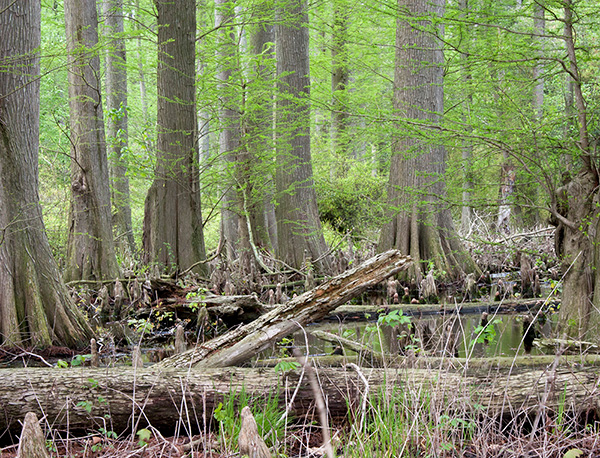There was a time when I began every morning by strapping my boots on… but that’s been a long time ago. Anymore, my morning routine is more likely to focus on a cup of coffee and finding my glasses.
But even old foresters enjoy a chance to visit the woods, and so I jumped at the chance last week when long-time SFI External Review Panel member (and consulting forester) Neil Sampson offered to take several of us on a tour of a truly unique forested wetland in Delaware. It turns out that this is a very special place, indeed… and a great example of the varied, and sometimes surprising, ways in which the SFI standard is applied to ensure sustainability.

It’s worth noting that the scale of this forested tract is itself unusual in Delaware, which is one of our smallest states, and one that has experienced a high degree of forest fragmentation. According to the USDA Forest Service, “Thirty-one percent of Delaware’s private timberland is now held in ownerships of less than 50 acres”, and, that “Delaware’s forests are highly fragmented, with few stands covering large acreages…”, noting that “forest fragmentation has had a detrimental effect on many bird species and other wildlife…” in the state. A recent study by David Mizrahi of New Jersey Audubon and Jeff Buler of the University of Delaware, revealed that the Great Cypress Swamp is one of the two most important stopover sites in Delaware for neotropical migratory songbirds during the spring and fall migrations. So the Great Cypress Swamp is important for a number of reasons, including the fact that it may be the largest remaining contiguous tract of privately owned forest left in the state.
Today, the hard working volunteers and staff of Delaware Wild Lands are focused on converting the current forests of sweetgum and red maple back to the historic condition of cedar and cypress. With newly installed water control structures in the drainage ditches, they are able to control the rate and timing of wetland flooding to facilitate the forestry operations necessary for restoration – truly turning the historical human impact into conservation opportunity. Meanwhile, income from the harvested off-site species helps fuel the activities of the land trust, and ensures that the forest itself is truly sustainable. Material harvested from the site has helped restore the historic farmhouse and outbuildings which now serve as the land trust offices at the Great Cypress Swamp.
And in a fascinating twist of “old meets new”, the staff uses a remote-control drone aircraft to delineate areas appropriate for planting cypress versus cedar – a task made tough on the ground by the fine differences in elevation. Atlantic white cedar seedlings are hard to come by, so Delaware Wild Lands has secured seed sources from the Great Dismal Swamp in Virginia, which has similar habitat and site conditions, ensuring suitability of the seedlings.
So what’s the connection with SFI? It turns out that the leadership of the Delaware Wild Lands recognizes the importance of SFI third-party audited certification in providing the necessary assurances of sustainability demanded by their stakeholders and the public. According to Executive Director, Kate Hackett, “SFI certification is important to us because it gives us social license to operate. Our Board of Directors, and the local community, can be confident about our forest restoration and management activities because they meet – even exceed – the standards of SFI.” Working with professionals at Vision Forestry, Delaware Wild Lands has developed a management and restoration plan that meets all the tests of sustainability and biodiversity protection that the SFI standards demand, while meeting their conservation-driven objectives.
It was good to strap on the boots again, and to see yet one more way that the SFI standards are helping to build (or restore…) the future forest.
